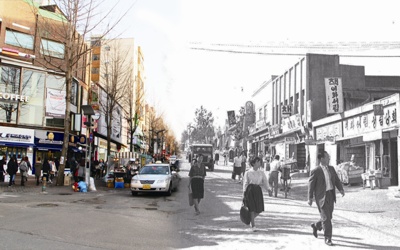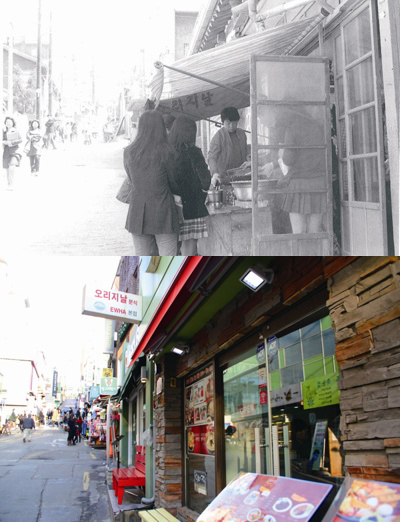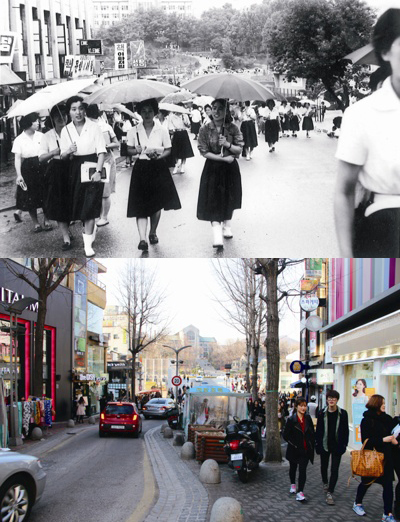Retracing memories of Ewha through changes of streets

It was 1935 when Ewha Hak-dang moved its campus from Jeong-dong to Sinchon and became Ewha Womans University. At that time, Ewhayeodae-gil – the street leading from the Ewha Womans University subway station to the school’s main gate – was a quiet, rural area surrounded by farmlands and houses. From then to the present, the street has gone through numerous changes until it has become one of the most popular tourist sites in Seoul today.
During the 1970s, Ewhayeodae-gil went through a quickening period on its way toward becoming today’s modern area. Stores such as boutiques, coffee houses, and some inexpensive bars filled the streets. People’s lives were much humble.
“There were shabby houses alongside the railroad to school, and girls about our age who worked in the clothing factory were also easily seen,” recalled professor Kim Hei-sook (Philosophy), who graduated from Ewha in 1976. “The contrast between those people and the school’s atmosphere made me contemplate poverty and social irregularities during school years.”
There were a lot of coffee houses in which students could spend time in front of the school. Additionally, there were one or two street vendors who sold small snacks such as rice puffs. Those snacks were very popular among Ewha students.
“I remember using large rice puffs as fans with my friends during the summertime,” said professor Yang Ok-kyung (Social Welfare), who entered Ewha in 1978. “Spending time in a coffee shop was also my favorite leisure activity. I chatted with my friends, and had a cup of coffee and snacks as my lunch there.”
Gami Bunsik, a restaurant that students still enjoy today, has been on the street since the 1970s. Ewha students back in the days also often found comfort in this restaurant and the professors who graduated from Ewha say it is one of the few remaining sites from the old Ewhayeodae-gil.

During the 1980s, Ewha became a mecca of fashion and style. The street experienced its golden days and was filled with boutiques and coffee houses, even more than those in the 1970s.
“Unlike the franchise cafés such as Starbucks today, Ewha students in my days enjoyed going to coffee houses,” said professor Yu Sae-kyung (Media Studies), who attended Ewha during the 1980s. “They were quite dark inside and the seats were divided by partitions. I talked with my friends while listening to music that DJs put on.”
Coffee houses such as Paris Da-bang were well-known places for students from Ewha and male students from elsewhere to meet each other. "During my days, I enjoyed spending time with my boyfriend and making friends in coffee houses after club activities,” professor Lee Yun-sil (Pharmacy) said. “I even had the chance to be one of the DJs, the so-called ‘Pandori’ (A compound word of pan that refers to a long-playing record, and dori, a friendly way to call a boy or a boy character) in these coffee houses since it was a popular job to earn some pocket money at that time.”

Ewhayeodae-gil was not only a hot place for Ewha students, but also for people from other universities.
“It is true that Ewha students enjoyed shopping in front of the school,” professor Lee Hwa-jeong (Pharmacy) said “In the evening, female students from other universities and office workers usually came for shopping. One of my friends tried to date a girl he met in front of Ewha, but it turned out that she was not Ewha student.”
Ewhayeodae-gil’s popularity for its uniqueness still exists throughout the years. In the 1990s, male students from various universities could often be found.
“There were so many male students at that time,” recalled Yang Sun-ja, the owner of a flower shop which has been standing besides Ewha since 1985. “After Yon-ko-jon (a joint festival between Yonsei and Korea University), the losers would cry in front of Ewha, pounding the ground with their fists, while the winners called for Ewha students”
The culture of fashion was further boosted during the 1990s.
“As far as I can remember, the clothing stores located in front of the school were even more crowded than it is now,” professor Chai Sang-mi (Business) said. “Today’s Ewhayeodae-gil seems much more arranged.”
Nowadays, Ewhayeodae-gil is not only a popular place for Koreans but also for foreign tourists. According to the JoongAng Ilbo, about 1,200 to 5,000 tourists visit the street daily for sightseeing and shopping. Even though the place is renowned as a famous tourist site in Seoul, some professors express concerns about the loss of its uniqueness.
“The school and the students should pay more attention to develop the street in some unique ways, not just consuming the culture surrounding them,” professor Kim said.
* Reporters: Lee Min-jeong & Chung Che-yoon
* Emails: mjlee@ewhain.net, thfl353@ewhain.net

